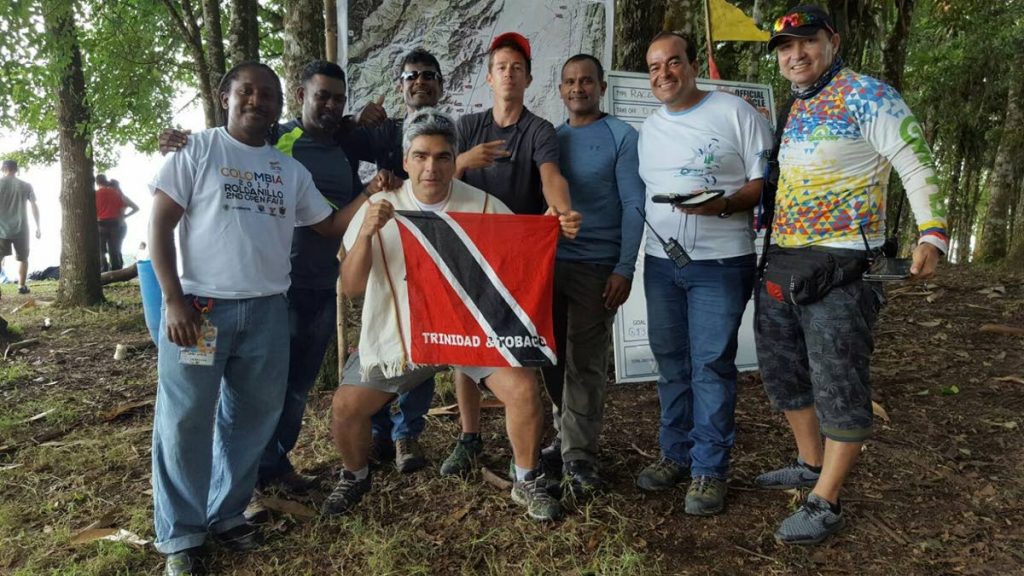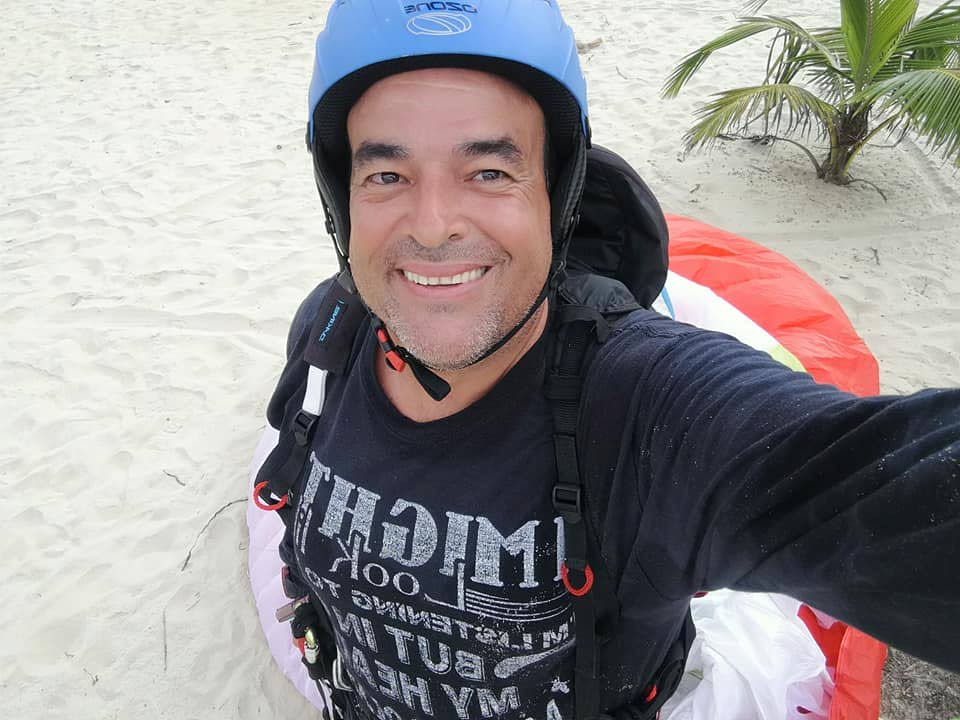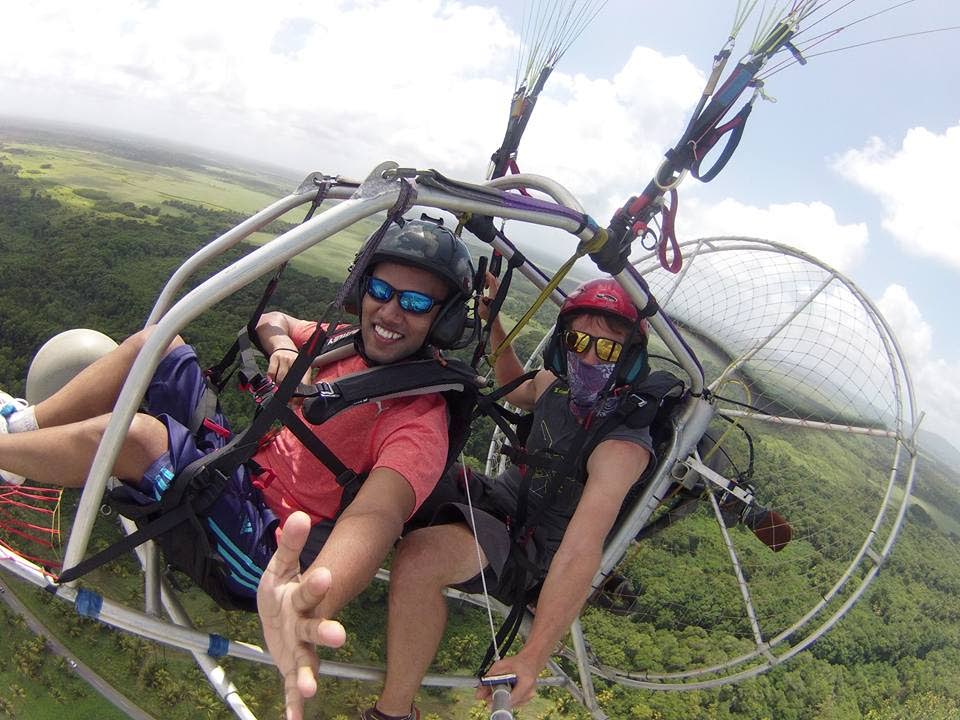Paraglider flies TT flag high

THE average human being may not be able to fly, but 46-year-old Juan Andrade certainly can. Well… sort of.
With 26 years of experience, Andrade continues to fly the TT flag high in the sport of paragliding. He was born in Caracas, Venezuela but moved to TT at a young age. He told Newsday he felt like he introduced the sport to TT.
“There’s this place (in Venezuela) called German Village (La Colonia Tovar). I used to go and admire how they were flying in the mountains and one day, I got the opportunity to learn to fly right there. Not too long after I learned, I came to Trinidad and I brought it with me.”
His first coach was Orlando Leyton, who came to TT to assist Andrade with finding a place to train as he wanted to build a team.
Paragliding should not be confused with parasailing or skydiving.
The paraglider is required to control their movement in the air with their equipment to complete a journey of a set distance, with no motorised assistance.
The main parts of the equipment are the harness, brake handles, risers, the wing and the reserve parachute in their backpack. The pilots depend on thermals and lifts for them to gain momentum and keep going. A thermal is a column of hot air that rises from the ground. The person may circle this until they reach the desired speed.

There are two types of lifts – a ridge lift and a wave lift. A ridge lift occurs when the wind blows against the hills or mountains, and the wave lift occurs closer to the downwind side of a mountain.
The expression commonly used when pilots utilise these lifts is “catching a lift.”
One must have a more in-depth knowledge of the wind and how it acts to truly master this sport.
Based on how they use the controls, the wing will change shape and so will the person’s navigation.
The equipment weighs an average of 45 pounds. So, in addition to one’s body weight, this also has to be taken into consideration.
Parasailers, on the other hand, have their equipment connected to a motorised vehicle to ensure the person’s safety and to assist with building up speed. It is strictly recreational, unlike paragliding, which is both recreational and a recognised professional sport.
Skydivers deal with free-falling and not free-flight like paragliders. Additionally, a skydiver aims to go down. Paragliders have to dodge natural obstacles and keep going upward continually. Skydiving is also a professional sport.

He said the ideal time to practise is between the hours of 11 am and 4 pm. His team, which has a total of 20 paragliders, tries to train two to three hours a day.
“It’s a very large, recognised sport,” Andrade told Newsday.
“It requires a very high level of discipline. It requires you to change your lifestyle and sacrifice a lot. You need to practise a lot, save a lot…”
Much like other sports, paragliding has different categories. Andrade mainly participates in three categories.
The first is the cross country category.
“(It requires) more training, you have to think a lot and use a lot of strategies.”
In the accuracy category, the glider has to “take off from the mountains” and land on a bullseye, according to Andrade.
And finally, there is the hike and fly category. The name is pretty self-explanatory, but the glider hikes a set distance and then takes off from the top of that mountain.
“It is very exciting and it is something I have been trying to push plenty. We actually do it two times a week. It is fun, pretty challenging.”
He said he has not had any major accidents or injuries throughout his career. He has also never been fearful of the sport itself, but rather if he would be able to continue doing well.
“Never the height. Nothing else,” he said.
He said the sport is quite expensive due to the cost of equipment. Also, spaces for the team to practise in TT are limited, so they often have to travel to train. And the sport does not receive any form of Government funding.

In TT, they use a motor with a propeller and this is called motorised or powered paragliding. Andrade said they mainly use this at the Manzanilla Beach.
It can either be used with one person inside, but it can also hold two people.
He said this type of training isn’t really advised for those who are professional in the sport since the equipment provides assistance.
The youngest person on the team is 18 and the oldest is 52 years old. While training sessions are fun, he admitted that he may not always get the opportunity to get as much as he wants out of every session.
“We went to do dynamic flying in Guayaguayare, and after spending two hours to help them take off and land, I finally said let me take a little flight.
“I took one land and needed to help someone else. Then I said, ‘You know what, let me just take photos.’”
Everyone in the team can ride bicycles, motorbikes, scuba dive, hike, and go spear fishing.
He said at competitions, after everyone else has landed safely and it is finally time for his category, the children tell him, “Okay. Go ahead and win now.”
In January, he participated in the British Winter Open in Colombia. He finished in 55th place out of 145 pilots in the 86 km race. Nikolaus Tang-lee, also from TT, placed 93rd.
Andrade then placed 41st out of 149 athletes in the 60 km event.
These were all in the cross country or “race to goal” category.
To Andrade, his team is like his second family. They are always happy to see any member of the team do well in the sport at competitions or in training sessions.
“I have one daughter and then I have 20 other children because everybody calls me every single day for whatever regardless of if it is paragliding or anything else.”
He said whenever he travels and sees equipment he thinks would be helpful to some members, he purchases it and gifts it to them.
“It’s a beautiful experience because knowing that you can actually carry someone to win and see that person coming back with a medal or with a trophy. And their face at the airport and they’re smiling and screaming; it is priceless.”
He thanked the TT Civil Aviation Authority for its continued assistance and partnership with the team over the years and hopes more people become encouraged to join the discipline.


Comments
"Paraglider flies TT flag high"